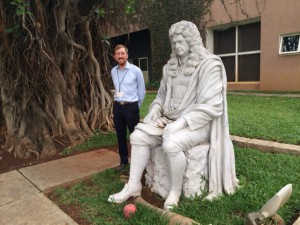2nd July 2014 New Delhi, India
Science is child’s play at IUCAA
Recently, I visited the Inter-University Centre for Astronomy and Astrophysics (IUCAA) in Pune, with my colleague Vishakha Chandhere who is based in Pune. As a Bangalorean, I was struck by how similar Pune and Bangalore felt – both cantonment towns with a significant military presence, relatively cooler than their surrounds, lots of trees and a seemingly more laid back approach to life compared to the bustle of Mumbai or Delhi. Set in the tree-covered campus of the University of Pune, IUCAA is India’s national centre for astronomy. They maintain a central repository of all the astronomers and institutes conducting research in astronomy in India, so they are a good starting point for anyone wanting to connect with the Indian astronomy community.
 The visit started with a meeting with some of the faculty where we discussed the recently announced Newton Fund and the kinds of support it might provide researchers in the UK and India. I was struck by the opportunities for collaboration which the faculty shared. For instance, IUCAA is coordinating India’s involvement in the Thirty Metre Telescope and overseeing the creation of the world’s third LIGO gravitational wave detector. They were very keen to explore how British researchers could be involved in designing and using those experiments, as well as getting access to some of the UK’s large science facilities.
The visit started with a meeting with some of the faculty where we discussed the recently announced Newton Fund and the kinds of support it might provide researchers in the UK and India. I was struck by the opportunities for collaboration which the faculty shared. For instance, IUCAA is coordinating India’s involvement in the Thirty Metre Telescope and overseeing the creation of the world’s third LIGO gravitational wave detector. They were very keen to explore how British researchers could be involved in designing and using those experiments, as well as getting access to some of the UK’s large science facilities.
The common theme to the researchers’ feedback about the tools necessary to support collaboration was that people (particularly PhDs and Postdocs) needed mechanisms to allow them to spend time in each others’ labs over a sustained period. This time can be used to exchange ideas, swap new techniques and design joint experiments. I don’t know yet quite what shape Newton programmes will take with India but I’m hopeful that activity like this could be supported through it.
After meeting the faculty, I had a tour of the beautiful IUCAA complex. Compact, well equipped and attractively modern buildings surround a grassy quad with statues of great names in astronomy. Appropriately, Newton can be found sat under a banyan tree (known as a thinking tree) but saplings cut from Newton’s apple tree are also growing nearby. The joke at IUCAA is that gravity was thought in India of sometime before Newton, but the genius in question was sat under a coconut tree at the moment of eureka and so never got a chance to share her insight.
The jewel in the IUCAA crown, at least for me, was across the road however. A large public auditorium and science centre, where kids come to experience hands on science, spoke of an institution truly committed to public outreach. I had a great time playing with the science ‘toys from trash’ that the centre designs to allow schools and children who have limited resources do practical science. All in all, a great visit to a really interesting Institute – I’d certainly recommend dropping by.
Lovely to read about the IUCAA which caught my attention because of Exeter’s own expertise in Astrophysics – http://emps.exeter.ac.uk/physics-astronomy/research/astrophysics/. Let’s hope the proposed Newton Fund allows for some enriching collaborative work in the sciences.